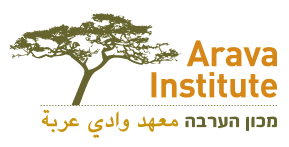LONG-TERM ACACIA MONITORING IN THE ARAVA VALLEY
The Arava Valley stretching from Eilat/Aqaba in the South to the Dead Sea in the North is a unique and fragile desert ecosystem shared by Israel and Jordan. At its heart are Acacia trees – a keystone species anchoring animal and human life in this extreme desert. With climate change causing an increase in droughts, and human impacts such as increased digging of wells and road development, it is suspected that the Acacia populations are decreasing, affecting the ecosystem of the region as a whole. Therefore, the center established an Israeli-Jordanian joint monitoring system that allows tree assessment in many locations and over a long period of time.
As a keystone species, the two species of Acacia are almost the only native trees found in the Arava valley and are responsible for shaping the landscape. As such, Acacias are extremely important as shade providers and as integral support for the survival of hoofed mammals. They provide a structural habitat for a wide variety of birds, reptiles, and invertebrates. For local human communities, acacia trees are important as a food source for livestock, a supply of wood, and a focus for tourism. They are of fundamental economic importance to Bedouin life in the desert.
In order to assess a tree’s health, the greenness must be determined. In most environments an index called Leaf Area Index (LAI) is used, but this method is not appropriate for hyper-arid ecosystems. Until recently, the method applied in hyper-arid environments was an evaluation based on the tree’s appearance. A more objective method using Normalized Difference Vegetation Index (NDVI) has been developed based on the reflection of leaves.
Normalized Difference Vegetation Index, defined as the ratio between near infrared reflectance to visible light, has been employed to monitor the density of live green vegetation. NDVI is measured on a scale of -1.0 to +1.0, with low values (0.1 and below) corresponding to barren areas of rock, sand or snow, moderate values (0.2-0.3) representing shrub and grassland, and high values (0.6-0.8) indicating temperate and tropical rain forests. Thus, high levels indicate large amounts of green material. NDVI has been used on samples of species Acacia tortillis, Acacia pachycera, and Acacia raddiana in the Arava Rift Valley.
Samples were monitored at the following locations: Evrona (54 trees sampled), Gidron (34), Hai Bar (56), Hatazevah (59), Iddan (26), Roded (50), Saif (60), Shahaq (90), Shezaf (62), Shlomo (74), Tzifnim (40), Tzihor (60), and Wadi Ktura (87). Across the thirteen sites, NDVI was measured for 752 trees in total. Each tree was measured once between the months of October and December 2014, with the exception of individuals in Wadi Ktura and Shlomo, which were measured in May 2014. Of the measured trees, 383 were Acacia raddiana, 220 were Acacia tortillis, 86 were Acacia pachycera, and 63 were not classified in any of the three categories as they were either dead or too young to identify. Monitoring will continue once a year.
Samples of species Acacia tortillis, Acacia pachycera, and Acacia raddiana have been monitored for the following parameters:
- height from the highest point on the tree (measured in meters using a laser or tripod, from the middle of the wadi facing north)
- foliage (measured by dividing the canopy into eight sections and assessing the leaf presence in each)
- foliage (expressed on a scale of 0-5 using photographs)
- canopy diameter facing north-south and east-west (measured in meters between the outermost branches)
- position of the tree in the wadi (characterized as central, edge of the active wadi, flood banks, slope, or plain)
- tree condition (alive, dry, appears dead)
- trunk circumference (measured in cm at a height of 1.3m with a tape measure)
- trunk Diameter at Breast Height (DBH measured in centimeters, sometimes using a dendrometer)
- height of the lowest leaf (measured in meters)
- height of browsing level facing north (measured in meters with the lowest leaves making up a line)
- percentage of Loranthus acaciae present
- quantity of fruit (measured on a scale of 0-2)
- quantity of flowers (measured on a scale of 0-2)
- quantity of pods on the ground (measured on a scale of 0-2)
- percentage of pod infestation (measured by picking 50 random pods and counting how many are not infested)
- number of seedlings around the tree (under the tree canopy)
In addition to individual tree monitoring, lab experiments for long-term acacia monitoring were conducted in Sde Boqer, for potted trees in Hatzeva, and in an acacia orchard.
Acacia Monitoring Updates 2018
In preliminary results, the Acacia pachyceras seems to be the most sensitive to decreased water supply. As the region’s keystone species, the trees provide food, shelter, and soil stability to nearly all of the animal and plant species in the region. Therefore, hopefully the research will demonstrate the urgency of the problem of climate change by highlighting the ecosystem-wide damage that will be caused by the loss of the Acacia pachyceras in the Arava.
For research purposes, The Center planted 135 trees to learn more about the different species responsiveness to differing quantities of water. They have been watered at different intervals for the past six years. In 2018, several different morphological characteristics were measured, such as tree height and canopy area.
There is some anticipation about losing the Acacia pachyceras in the coming years due to the effects of climate change. Because it’s origin is farther north in the Arava, this species is less adapted to the drought-like conditions in the region. Lowered levels of precipitation are anticipated for the future of the hyper-arid Arava desert; this study was designed to test each species’ response to decreased quantities of water, 25% and 12.5% of the water needed by the acacias currently.
In preliminary results, the Acacia pachyceras show the most sensitivity to decreased water supply. As the region’s keystone species, the trees provide food, shelter, and soil stability to nearly all of the animal and plant species in the region. The research intends to demonstrate the urgency of the problem of climate change by highlighting the ecosystem-wide damage that will be caused by the loss of the Acacia pachyceras in the Arava.
Inbal Pipman, Rachamim Shemtov, Heidi Reinheimer, Nitzan Segev
Wadi Araba was surveyed together with DESHE (part of the Society for Protection of Nature), the INPA (Israel Nature and Park Authority), MARAG (Israel ecosystem consortium), KKL (Forestry department), the Arava LTSER platform, and SAWA (Jordan LTER).

